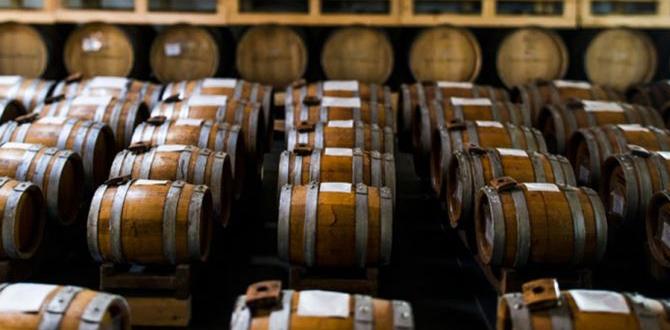Quick Summary
Discovering hidden gem restaurants abroad transforms travel, offering authentic flavors beyond tourist traps. Our guide helps you find these local treasures, ensuring unforgettable culinary experiences and genuine connections with destinations.
Ever dreamt of savoring a dish so perfectly local it feels like a delicious secret? Traveling is amazing, but sometimes the best experiences are tucked away. It can be tricky to find those truly special, non-touristy eateries when you’re in a new place. Don’t worry, though! We’re here to guide you through the exciting world of finding incredible hidden gem restaurants abroad. Get ready for a taste adventure that’s both simple and deeply rewarding. Let’s explore how to uncover these culinary diamonds!
Your Passport to Authentic Flavors: Finding Hidden Gem Restaurants Abroad
As Joseph Bryant from FoodsGuider, I believe that food is the heart of any culture. Exploring the world through its flavors is one of life’s greatest joys. While iconic dishes and famous eateries have their place, there’s a special magic in stumbling upon a little-known spot. These are the places where locals gather, where recipes are passed down through generations, and where the price often reflects the genuine value, not the tourist markup.
Finding these “hidden gems” can feel like a quest. You want that authentic experience, that unforgettable meal that tells a story. But how do you go from a bustling foreign street to a quiet, delicious discovery? It’s easier than you think with the right approach. We’ll break down how to uncover these culinary treasures, making your next trip a delicious success, no matter your destination.
Why Seek Out Hidden Gem Restaurants Abroad?
The allure of a hidden gem restaurant is multifaceted. It’s not just about the food, though that’s a huge part of it! It’s about the entire experience.
- Authenticity: These are the eateries where you’ll find true local cuisine, prepared with traditional methods and ingredients.
- Unique Flavors: Step away from the generic and discover dishes you won’t find anywhere else, often unique to a specific region or even a single family.
- Cultural Immersion: Eating where locals eat is a fantastic way to understand the culture. You’ll observe daily life, hear the local language, and feel more connected to the place.
- Better Value: Often, hidden gems offer incredible quality at a more reasonable price than well-known tourist spots.
- Unforgettable Memories: The thrill of discovery and the satisfaction of a truly amazing meal create lasting travel memories.
The Challenge: Navigating Unfamiliar Territories
The biggest hurdle in finding these elusive spots is, of course, the unfamiliarity. Without local knowledge, you’re often relying on guidebooks or online reviews that might heavily feature the more popular, and thus more crowded, places. Language barriers can also make asking for recommendations feel daunting.
Walking into a restaurant without knowing what to expect can be a gamble. You might end up with a disappointing meal or an uncomfortable experience. But what if you could equip yourself with strategies to significantly increase your chances of finding that perfect, unassuming eatery? That’s exactly what FoodsGuider is here to help you do!
Phase 1: The Strategic Hunt – Research Before You Go
The foundation of finding hidden gems starts long before you even pack your bags. A little bit of pre-trip research can make a world of difference. Think of this as gathering your culinary intel.
Leveraging the Internet Wisely
The internet is a treasure trove, but you need to dig a little deeper than the first page of search results. Here’s how to refine your online search:
- Beyond Top 10 Lists: Instead of searching for “best restaurants in [city],” try more specific, local-centric queries.
- Local Blogs and Forums: Search for “[city name] local food blog,” “[city name] food forums,” or “[neighborhood name] eats.” These often feature more niche recommendations.
- Google Maps & Street View: Once you’re looking at a specific neighborhood, zoom in on Google Maps. Look for clusters of restaurants that don’t have many English reviews or photos. Use Street View to get a feel for the place.
- Social Media Deep Dives: Use Instagram hashtags like #[cityname]eats, #[cityname]food, or #[countryname]foodie. Look for posts from locals or smaller food accounts. Pay attention to what they’re sharing!
- Niche Travel Sites: Explore websites dedicated to authentic travel or food experiences. For instance, Atlas Obscura often highlights unique culinary spots, not just sights.
Specific Search Terms to Try
Here are some examples of search terms that can help you uncover those lesser-known spots:
- “Authentic [dish name] [city name]” (e.g., “Authentic Kimchi Jjigae Seoul”)
- “Traditional family restaurant [neighborhood name]”
- “Where do locals eat in [city name] off the beaten path”
- “[City name] cheap eats local”
- “Neighborhood restaurants [city name]”
Checking Reputable Food Resources
While mainstream guides are good for a start, look for resources that focus on in-depth culinary exploration:
- Local’s Guides: Many cities have unofficial “locals’ guides” created by residents. A quick search for “[city name] local’s guide food” can yield great results.
- Michelin’s Bib Gourmand: For a more curated list, check the Michelin Guide’s Bib Gourmand section. This highlights restaurants offering great food at moderate prices, often less formal than their starred counterparts.
- Eater Guides: Eater often has city-specific guides that are more detailed and community-focused than standard travel articles.
Phase 2: The On-the-Ground Tactics – Finding Gems When You Arrive
Research is key, but sometimes the best discoveries happen spontaneously. Here’s how to keep your eyes and ears open once you’re exploring.
Observe and Listen
Your senses are your best tools when you’re out and about. Pay attention to what’s happening around you:
- Follow the Locals: If you see a line of locals outside a small eatery, it’s usually a good sign.
- Busy at Off-Peak Hours: A busy restaurant during typical “off” times (like mid-afternoon on a weekday) often indicates it’s a local favorite.
- Observe the Menu: Look for menus that are primarily in the local language, with simple translations (or no translations at all). This suggests it’s catering more to locals.
- Kitchen Visibility: If you can see into the kitchen, and it looks clean and busy, that’s often a positive indicator.
Don’t Be Afraid to Ask
Asking for recommendations is one of the most effective ways to find hidden gems. Here’s how to do it effectively:
- Ask Non-Touristy Staff: Instead of asking hotel concierges (who might point you to places they have partnerships with), try asking people like market vendors, shopkeepers, or your barista at a local coffee shop.
- Be Specific: Instead of “Where’s good to eat?”, try “Where do you go for a really good, traditional [local dish]?” or “What’s your favorite casual place for lunch around here?”
- Learn a Few Phrases: Even a simple “Where is a good local restaurant?” in the local language can go a long way.
Navigating Restaurant Signage
Restaurant fronts can tell you a lot. Here’s what to look for:
- Simple Signage: Overly flashy or multilingual signs can sometimes indicate a place geared towards tourists. Simple, local-language signs are often a good sign.
- Family Photos or Awards: Sometimes, these small places will display old family photos or local newspaper clippings, hinting at a long history or local acclaim.
- “Menu del Dia” or Daily Specials: These often indicate fresh, seasonal ingredients and good value, typical of local favorites.
Use Technology on the Go
While you want to avoid purely tourist-centric apps, some can still be helpful:
- Google Maps: Even while walking, you can search for “restaurants” and then filter by rating or see what’s nearby. Look at the photos and recent reviews for clues.
- Local Transport Apps: Sometimes, when you buy a ticket for a local bus or metro, you can see nearby points of interest, including restaurants.
Phase 3: Decoding the Experience – What Makes a Gem Shine?
Once you’ve found a potential gem, how do you know it’s truly special? It’s more than just the food being edible!
The Menu Matters
What’s on the menu can be a strong indicator. Keep an eye out for:
- Seasonal Offerings: Restaurants that highlight seasonal ingredients are often more connected to local produce and traditions.
- Limited, Focused Menu: A shorter menu can mean the kitchen excels at what it does, rather than trying to do too many things poorly.
- Local Specialties: Look for dishes that are specific to the region you’re in.
- Handwritten or Simple Print: Especially in very traditional spots, a handwritten menu or one with minimal English can mean you’re in for a truly local experience.
The Vibe and Ambiance
The atmosphere speaks volumes. What should you look for?
- Warmth and Welcome: Even if there’s a language barrier, a friendly gesture or smile from the staff goes a long way.
- Authentic Decor: It doesn’t need to be fancy. Simple, clean, and perhaps a bit worn can be a sign of a well-loved, long-standing establishment.
- Local Clientele: Are you seeing families, workers, and groups of friends who seem like they regularly dine there? That’s a great sign.
Food Quality and Taste
Ultimately, the food has to deliver. Here are some cues:
- Freshness: The ingredients should taste fresh and vibrant.
- Flavor Depth: Dishes should be well-seasoned and have complex, satisfying flavors.
- Presentation: While not always fancy, the food should look appealing and thoughtfully prepared.
- Portion Size: Often, local eateries offer generous portions that reflect good value.
Table: Comparing Tourist Traps vs. Hidden Gems
To help you visualize the difference, let’s compare what you might find when you’re just wandering versus when you actively seek out hidden gems. This isn’t to say all tourist traps are bad, but if you’re after authenticity, this is what to expect:
| Feature | Typical Tourist Trap | Authentic Hidden Gem |
|---|---|---|
| Location | Prime tourist areas, near major attractions. | Side streets, residential neighborhoods, away from main thoroughfares. |
| Menu | Extensive, multilingual, standardized dishes, often “international” options. | Focused, seasonal, primarily in local language, regional specialties. |
| Price | Higher, reflecting prime location and tourist demand. | More moderate, reflecting local economy and value. |
| Ambience | Often caters to tourist expectations, sometimes generic. | Local chatter, authentic decor, reflects community life. |
| Staff | May be less engaged, focused on quick turnover. | Often friendly, proud of their food, may be happy to explain dishes. |
| Reviews | Abundant English reviews, often about convenience or view. | Fewer reviews, mostly in local language, focus on taste and authenticity. |
Tips for a Smooth Experience at Hidden Gem Restaurants
Once you’ve found your diamond in the rough, how do you ensure a fantastic dining experience? Here are some practical tips:
Mastering the Language Barrier
Don’t let language be a roadblock! Simple tools and gestures can bridge the gap.
- Translation Apps: Google Translate or similar apps are invaluable. You can type, speak, or even point your camera at the menu for instant translation.
- Picture Menus: Some places, especially smaller ones, might have photos of their dishes. Pointing at a picture is universally understood!
- Gestures and Pointing: Don’t underestimate the power of a smile and pointing.
- Ask for “Chef’s Special” or “Local Favorite”: This can bypass complex ordering.
- Learn Basic Phrases: “Hello,” “Thank you,” and “Delicious” in the local language can earn you smiles and good will.
Understanding Local Dining Etiquette
Each culture has its own way of doing things. A little awareness can prevent awkward moments.
- Meal Times: Be aware of when locals typically eat lunch and dinner. Some smaller establishments might close between lunch and dinner.
- Tipping: Tipping customs vary greatly. Research this for your destination beforehand. In some countries, service is included; in others, a tip is expected.
- Sharing Dishes: In many cultures, especially in Asia and parts of Europe, sharing dishes is common and a great way to try more things.
- Noise Levels: Some busy, local places can be quite noisy. Embrace it as part of the atmosphere!
Handling Payment
Be prepared for different payment methods:
- Cash is King: Many smaller, hidden gem restaurants might only accept cash. Always have some local currency on hand.
- Local Payment Apps: In some countries, specific payment apps are more popular than credit cards.
- Check Before You Commit: If you plan to use a credit card, it’s wise to check if they accept them before you sit down, especially if it’s a cash-only sign.
Patience is a Virtue
These places are often run by families or small teams. Service might not be as fast as a chain restaurant, but the wait is usually worth it. Relax, enjoy the atmosphere, and anticipate the deliciousness to come!
Showcase: A Few Examples of Hidden Gem Philosophies
To illustrate the concept, let’s look at a few hypothetical (but very common) types of hidden gems you might encounter:
The Family-Run Trattoria (Italy)
Imagine walking into a small, bustling trattoria down a narrow cobblestone street. The air is filled with the aroma of garlic and simmering tomatoes. Mamma is in the kitchen, Nonna is taking orders, and the menu is a handwritten board listing only a few pasta dishes and a couple of secondi.
- Key Features: Authentic regional pasta, often a daily special based on market finds, strong family pride in their recipes, limited wine selection focusing on local vino.
- Why it’s a Gem: You’re tasting recipes perfected over generations, made with love and the freshest local ingredients. The experience is personal and genuinely Italian.
The Neighborhood Bistro (France)
This isn’t a Michelin-starred establishment but a cozy spot in a residential area. Locals pop in for a simple, well-prepared dish after work. The menu might change weekly, featuring classics like Coq au Vin or Bouillabaisse on specific days.
- Key Features: Fresh, seasonal ingredients, classic French comfort food done right, reasonable prices, lively but relaxed atmosphere.
- Why it’s a Gem: It’s the everyday culinary heart of France. You get a taste of true French home cooking without the pretension or high cost of famous restaurants.
The Street Food Stall Extraordinaire (Thailand)
Forget fancy restaurants; sometimes the best meals come from a humble cart on a busy street. This stall might specialize in just one or two dishes, like Pad See Ew or Boat Noodles, made with secret family chili paste and perfectly wok-charred noodles.
- Key Features: Incredibly fresh, fast, and flavorful food; expert preparation honed over years; very affordable; often located in specific markets or street corners known to locals.
- Why it’s a Gem: You’re experiencing the authentic, vibrant street food culture that is central to Thai life. The flavors are intense and unforgettable!
The Izakaya (Japan)
A small izakaya (Japanese pub) tucked away in a Tokyo alley. It’s dimly lit, filled with the murmur of conversations and the clinking of glasses. The menu is a mix of





